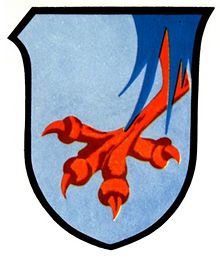
Back Kampfgeschwader 76 German Kampfgeschwader 76 French Kampfgeschwader 76 Portuguese Kampfgeschwader 76 Slovenian
| Kampfgeschwader 76 | |
|---|---|
 Emblem of Kampfgeschwader 76 | |
| Active | 1939–45 |
| Country | |
| Branch | |
| Type | Bomber Wing |
| Role | Air interdiction close air support Offensive counter air Maritime interdiction Strategic bombing |
| Size | Air force group |
| Engagements | Polish Campaign Battle of the Netherlands Battle of Belgium Battle of France Battle of Britain Eastern Front Mediterranean, Middle East and African theatres Western Front |
| Insignia | |
| Identification symbol | Geschwaderkennung of F1 |
Kampfgeschwader 76 (KG 76) (Battle Wing) was a Luftwaffe bomber Group during World War II. It was one of the few bomber groups that operated throughout the war.
In 1933 Adolf Hitler and the Nazi Party came to power in Germany. To meet the expansionist aims of their Führer, the German state began an enormous rearmament programme to build the Wehrmacht (German armed forces). KG 76 was created in May 1939 as the Luftwaffe sought to reorganise and increase its strength. The wing was permitted three Gruppen (Groups) in May 1939, but only two were operational by August. The Dornier Do 17 light bomber equipped the wing's units.
In September 1939 German and Soviet forces invaded Poland, beginning World War II. KG 76 served in the campaign until the 17 September 1939 and then proceeded to spend the Phoney War resting and re-equipping. All three groups began the offensive in Western Europe (Fall Gelb) on 10 May 1940. KG 76 supported the German Army (Heer) in the Battle of Belgium and Battle of France. In July 1940 KG 76 served in the Battle of Britain and The Blitz until May 1941. During the course of these operations it converted to the Junkers Ju 88.
From June 1941 KG 76 supported Army Group North in Operation Barbarossa, the invasion of the Soviet Union. It remained on the Eastern Front until December 1942 and never returned. From December 1942 to January 1944 it operated exclusively the Mediterranean and Middle East theatre, mainly in the Maritime interdiction role. It participated in the Battle of Tunisia, in the final phase of the North African Campaign (November 1942—May 1943) and also in the Italian Campaign, from July 1943 until May 1944. Some of its staffeln converted to the Messerschmitt Me 410 and Junkers Ju 188 in the spring, 1944.
Some of KG 76s Gruppen saw service on the Western Front in the night intruder role because of Allied air superiority. It formed part of the bomber force for Operation Steinbock and contested the D-Day landings in the summer, 1944. It was withdrawn from the Battle of Normandy after heavy losses. KG 76 continued to operate over the Low Countries and supported the Ardennes Offensive in the Aerial reconnaissance and close air support role. Significantly, KG 76 made use of the first-ever operational jet bomber design, the Arado Ar 234. KG 76 remained operating on the West Front until May 1945, one of the few bomber units to do so.
The last remaining groups either withdrew to Norway on 3 May 1945 or surrendered to the British Army in northern Germany on 8 May 1945.